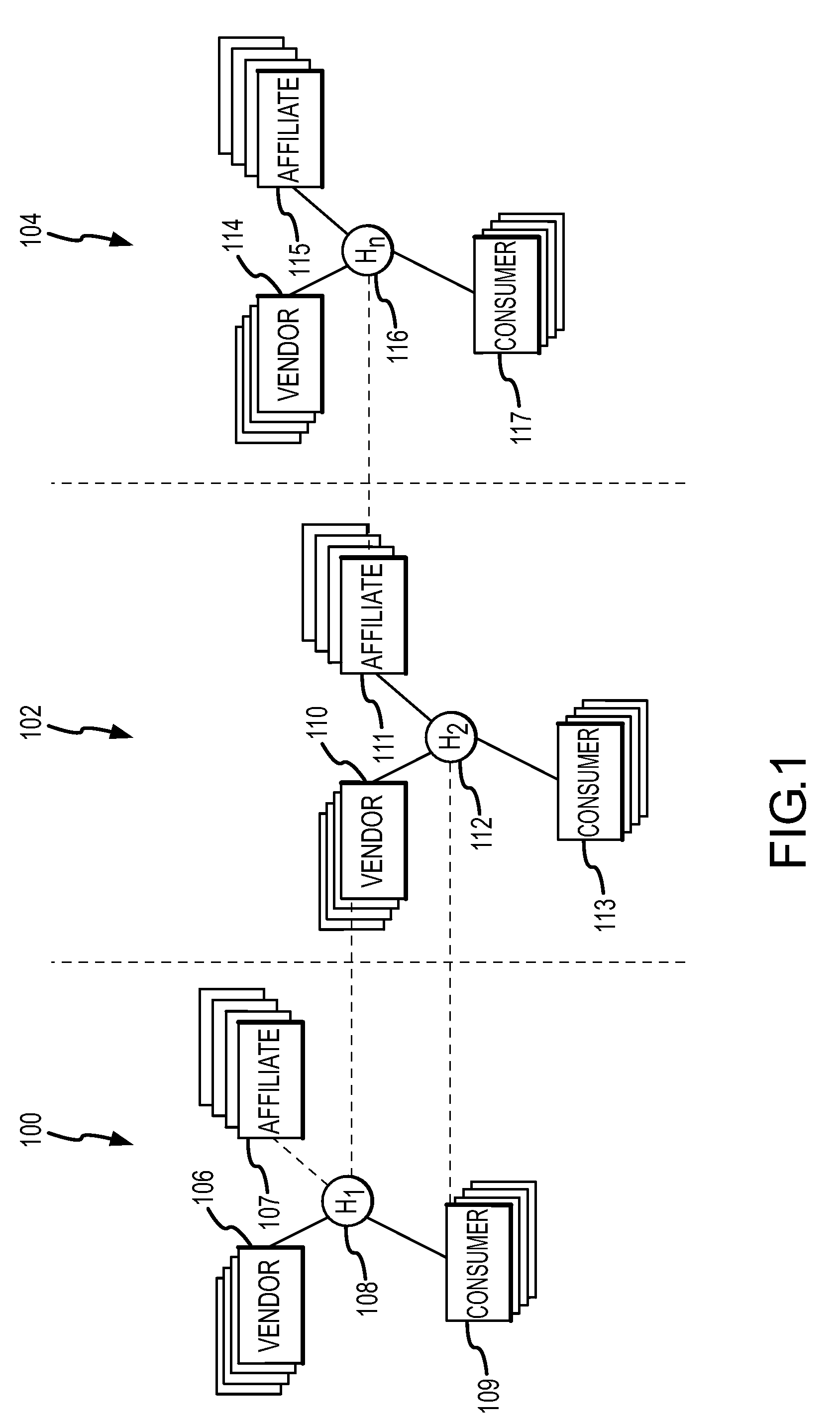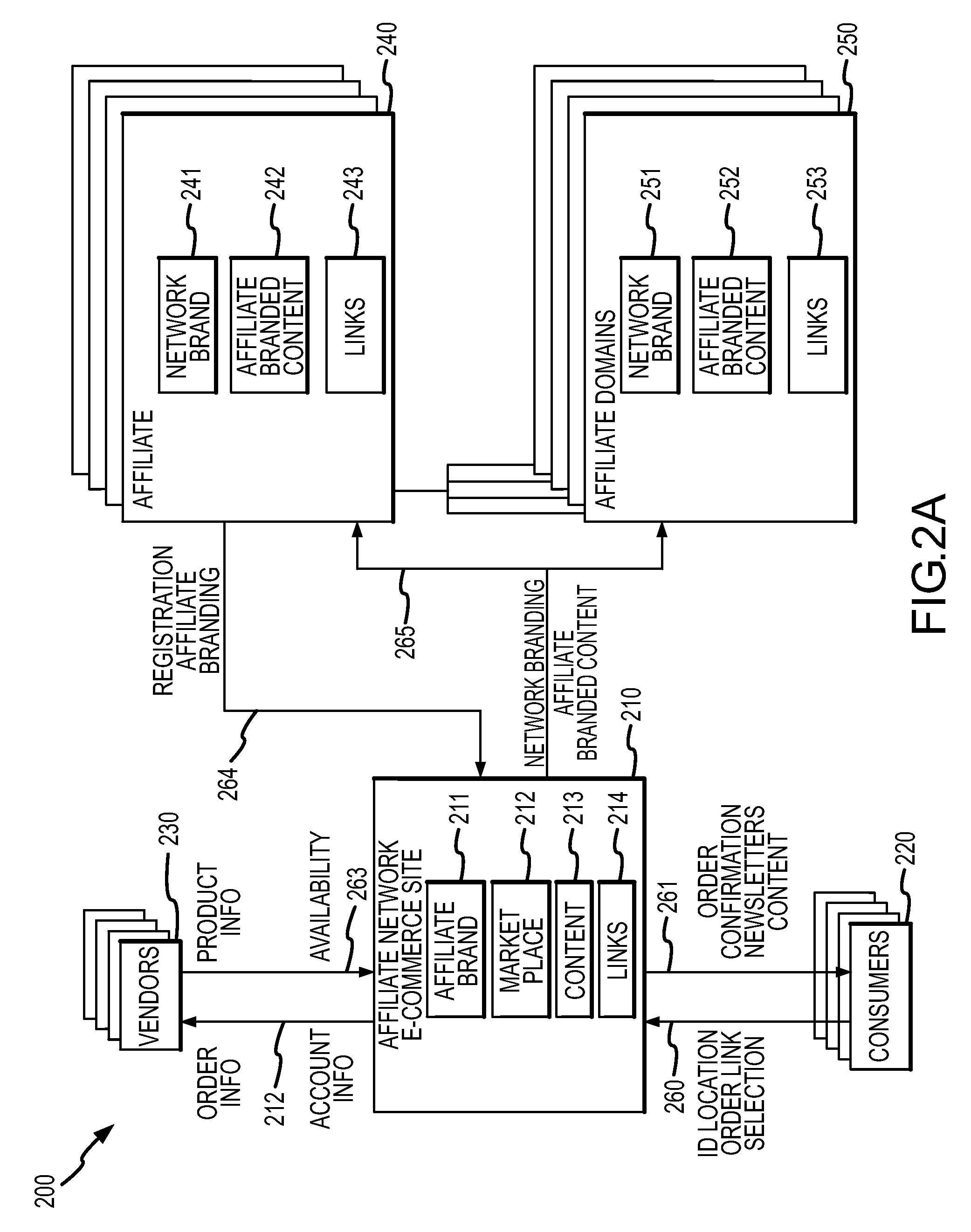[0008]It will be appreciated that the conceptualization of the number of tiers and the vertical relationship of such tiers is somewhat flexible. Regardless of the conceptualization, complementary business interests result from a common target
consumer class and / or unifying
subject matter. Thus, in the yoga industry example, students of local yoga studios are likely purchasers of yoga related products and vice versa. Bicycle manufacturers may benefit from the presence of local bike shops who can provide expertise and test-rides, while bike shops may have the opportunity to sell accessories and services to end users of bicycles. This social relationship between vendors can become a valuable asset to other businesses participating in the social network.
[0009]Therefore this invention presents the opportunity for the individual business / market space to itself benefit from the capability to connect multiple vendors to an affiliate-based collective (i.e. yoga studios and their customers, bike stores and their customers, etc.) and simultaneously the opportunity for the individual business / market space to benefit from the capability to connect with and share vendors, products, advertisers and even customers with other individual businesses and market places who connect with and use the social networking platform for business-to-business trading purposes. In other words, each “portal” becomes not only a stand-alone
business entity, but rather an entity that is connected to and can benefit from the larger network of portals / market spaces. Further, the
economic benefits of sharing information, resources, vendors, products and customers is inherent in the unique functionality and processes of the invention.
[0011]The present invention addresses these needs and objectives by providing a social networking business-to-
business environment where an e-commerce platform or
system and associated functionality consolidates an existing or potentially tiered vertical market space by connecting multiple market spaces / portals and their vendors and products to a target audience or consumer class through an affiliate network. In this manner, market spaces / portals (e.g. bike market space or yoga market space); affiliates (e.g., bike shops or yoga studios) and vendors (manufacturers or sellers of bicycles or yoga-related products) can be linked to an e-commerce platform in a manner that promotes realization of potentially complementary relationships. For example, the market spaces / portals may contain vendors and products that are complementary such as, in the case of a bike market space and yoga market space, an energy bar vendor / product or a
sports drink vendor / product. Further, the affiliate network (bike stores, yoga studios) can drive e-commerce traffic to the e-commerce platform where vendors' products and / or services are available. Affiliates can receive content from the e-commerce platform, for example, related to the relevant industry (e.g., bike training tips, yoga educational materials and spiritual resources or information about mortgage options, interest rates or mortgage calculators, etc.). Such content may expedite affiliate site construction, and enhance the value of the affiliate site to their customer base. Additionally, when consumers are referred (e.g., linked) to the market space / portal / e-commerce site by a referring affiliate, affiliate branding may be included in connection with the e-commerce platform, and
referral fees may be provided to the affiliate, thereby generating a further revenue
stream for the affiliate. Consumers benefit from enhanced site content,
exposure to complementary products and services of likely interest, and one-stop shopping without the bewildering array of unrelated options. Businesses can participate on many levels in the manner and options in which they choose to share resources. For example, the social network can facilitate sharing of vendor relationships, services provided (such as banking or merchant accounts), customer mailing lists, and production. There is an unlimited set of resources that can be established for a business-to-business relationship enhanced through the social network established by the invention.
[0012]The social networking business-to-business platform provides functionality that can increase traffic and
visibility of the affiliate
web site. Specifically, any number of Internet domain names owned by the social networking business-to-business platform user which may, but do not have to be, directly relevant to the vertical market space (i.e., for the yoga industry example, www.heropose.com, www.childrensyogastie.com, www.yogafortheworld.com, etc.; for the bike industry example, www.theworldofbikes.com, www.bikeracing.com etc.) can be entered into the
system. Any new affiliate is automatically listed and linked on these Internet
domain name pages / web sites. This can improve
visibility and traffic to the affiliate's
web site by a targeted set of consumers in the vertical market. It will be appreciated that increasing the number of domain names associated with
a site increases the likelihood of the site being found by relevant users. Indeed, users frequently simply type domain names in their browsers which they feel are related to their topic of interest. The present invention automates this process of listing
multiple domain names and linking the names with affiliate web sites in a vertical market.
[0017]In accordance with another aspect of the present invention, branding information (e.g., a
trademark or other identifying information) is exchanged between platforms of an affiliate network so as to enable co-branding of site content. As discussed above, the affiliate network includes vendors, consumers and affiliates integrated with respect to a social networking business-to-business system. It is noted that conventional e-commerce systems, e.g., portal sites with a number of partnering vendors, may identify the vendor source of products, but generally do not involve co-branding of vendor sites or allow vendors to co-brand content at the e-commerce site. Indeed, because the business models of such conventional e-commerce site are largely dependent on drawing traffic to, and retaining traffic on, such sites, there is a significant incentive to uniquely impress the e-commerce site identity upon visitors, and not cultivate a multi-entity
network identification. The social networking business-to-business platform allows for this conventional model to be greatly expanded in such a way that has not been previously possible.
[0020]In accordance with a still further aspect of the present invention, an affiliate network is used to enable
targeted advertising. It will be appreciated that some portal sites have become so generalized with respect to product offerings as to significantly impair the ability of advertisers to obtain targeted commercial impressions. By contrast, the very nature of an affiliate network draws consumers having a common interest and, in some cases, additional common demographic classifications. Moreover, as noted above, location information can be associated with at least some consumers of an affiliate network (e.g., based on a newsletter registration or transaction-related information). The affiliate network thus provides enhanced opportunities for
targeted advertising. An associated utility involves: establishing an affiliate network that is part of the social networking business-to-business platform related to a defined industry; providing an advertisement in connection with one or more platforms of the affiliate network; and billing for delivery of the advertisement based on targeted commercial impressions. For example, such billing may be based on visits to the one or more platforms and / or clicks on the advertisement.
 Login to View More
Login to View More  Login to View More
Login to View More 


